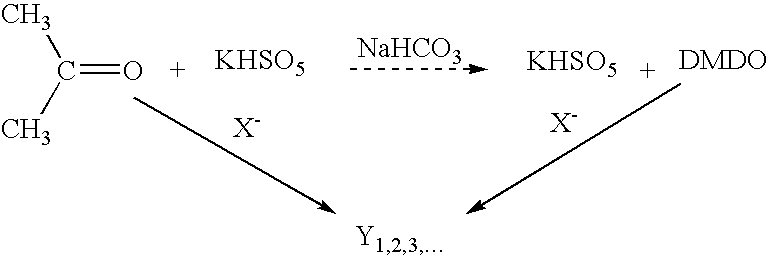Universal halide-enhanced decontaminating formulation
a technology of halide-enhanced decontamination and formulation, applied in the direction of detergent bleaching agent, detergent compounding agent, disinfection, etc., can solve the problems of presenting hazards to the handler(s) and surface materials, hindering their practical use, and not revealing any effect toward biological agents
- Summary
- Abstract
- Description
- Claims
- Application Information
AI Technical Summary
Benefits of technology
Problems solved by technology
Method used
Image
Examples
example 1
[0040]As shown in the table below, reactivity towards the degradation of Paraoxon, an organophosphorus pesticide and G-agent simulant, was observed when exposed to a neutral monopersulfate-chloride solution of the present invention, as well as controls chloride alone and monopersulfate alone. The tests were conducted over a period of three hours, using 8.7 umol Paraoxon, at 20-22° C., with the controls and decontaminant present in 100 mL batch systems in deionized water. Batch system concentrations of reactants, as applicable, were 6.2% w / v sodium bicarbonate (12% w / v for pH 8.5 studies), 3.6% w / v sodium carbonate (only for pH 8.5 studies), 10% w / v monopersulfate (Oxone®), 5.4% w / v sodium chloride, and 10% w / v potassium sulfate. The results indicated that chloride alone and monopersulfate alone were considerably ineffective at achieving degradation of this form of substrate, while the combination of the present invention at both pH 7 and pH 8.5 demonstrated a significant increase of...
example 2
[0046]For biological studies, the following table shows a monopersulfate-chloride system that achieved 7-log inactivation of Bacillus thuringiensis spores (an anthrax simulant) in 50 mL systems at 20-22° C., within 10 minutes of exposure, exceeding the kill efficiency of buffered monopersulfate alone. System concentrations of each reactant, as applicable, were 10% w / v monopersulfate (Oxone®), 5.4% w / v sodium chloride, 6.2% w / v sodium bicarbonate, and 10% v / v acetone (for generation of a dimethyl dioxirane (DMDO) in the presence of buffered monopersulfate), all at pH 7.4.
[0047]
BatchInactivationSystem10 mins.Bicarbonate Control0Chloride Control0Monopersulfate 99.9185%Monopersulfate + Chloride>99.99999%Acetone + Monopersulfate (DMDO) + Chloride>99.99999%
[0048]The in situ generation of triiodide was also measured from a system to which iodide salt was added to a dilute aqueous solution of buffered monopersulfate. It is known that oxidized species of bromide and iodide are powerful disi...
PUM
| Property | Measurement | Unit |
|---|---|---|
| pH | aaaaa | aaaaa |
| pH | aaaaa | aaaaa |
| pH | aaaaa | aaaaa |
Abstract
Description
Claims
Application Information
 Login to View More
Login to View More - R&D
- Intellectual Property
- Life Sciences
- Materials
- Tech Scout
- Unparalleled Data Quality
- Higher Quality Content
- 60% Fewer Hallucinations
Browse by: Latest US Patents, China's latest patents, Technical Efficacy Thesaurus, Application Domain, Technology Topic, Popular Technical Reports.
© 2025 PatSnap. All rights reserved.Legal|Privacy policy|Modern Slavery Act Transparency Statement|Sitemap|About US| Contact US: help@patsnap.com


